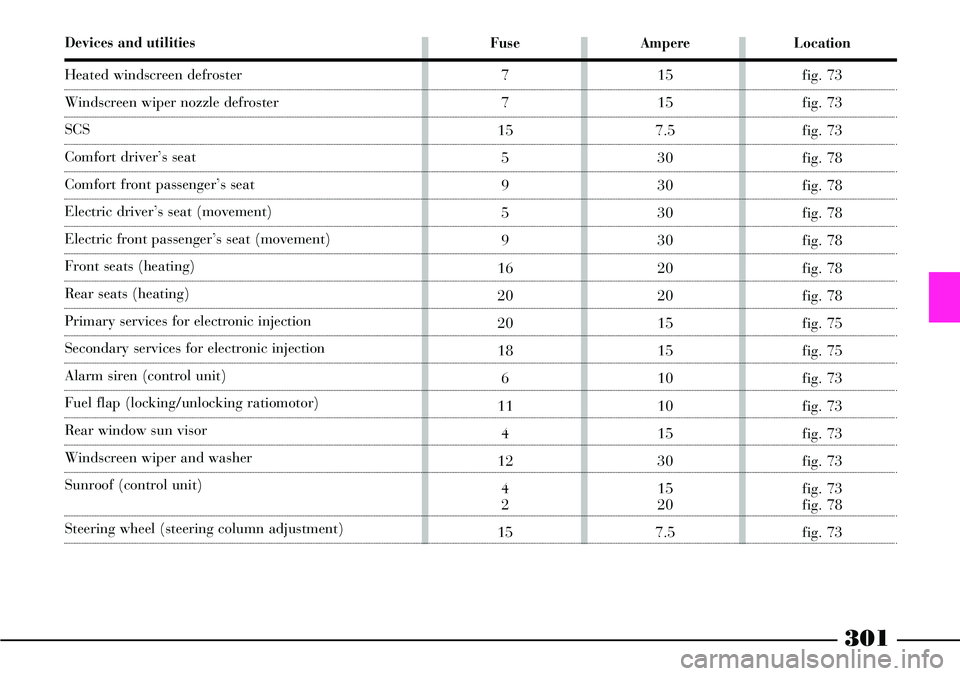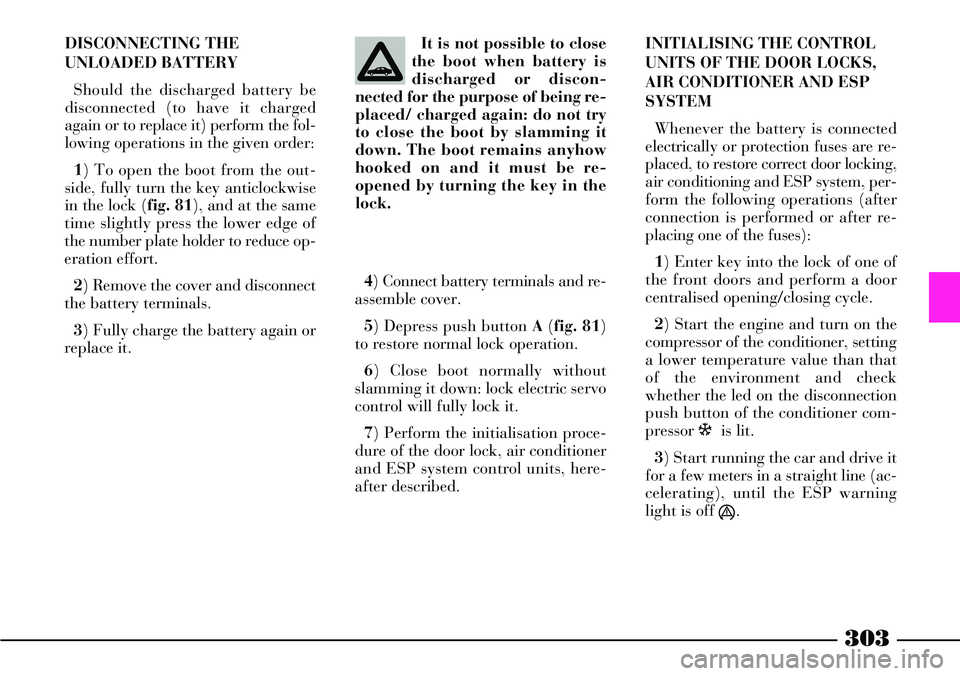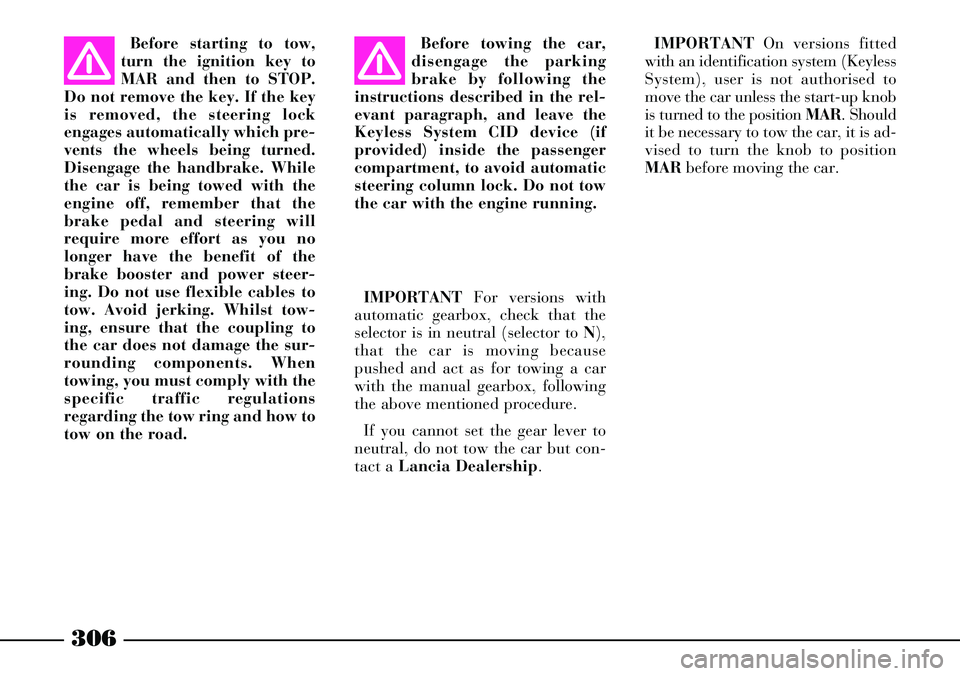Lancia Thesis 2007 Owner handbook (in English)
Manufacturer: LANCIA, Model Year: 2007, Model line: Thesis, Model: Lancia Thesis 2007Pages: 386, PDF Size: 8.69 MB
Page 301 of 386

300
Devices and utilities
Passenger door point (power supply)
Instrument panel point
Steering angle sensor point
(*) As an alternative for certain versions/markets
Parking sensor point
TV tuner point
Boot point
Steering wheel point
Central console control panels
Fuel pump
Doors (electrified lock actuators)
Spark plug pre-heating
EOBD system diagnostic socket
Current socket in boot
Current socket in rear armrest
Parking heater (control unit)
Additional heater
Fuse
10
14
16
19 (*)
13 (*)
19
15
14
15
11
15
15
21
11
2
6
22
13
2
3
4
9
Ampere
20
10
10
10
10
7.5
7.5
10
7.5
20
7.5
7.5
15
20
60
10
20
20
15
20
50
20
Location
fig. 73
fig. 73
fig. 73
fig. 78
fig. 73
fig. 73
fig. 73
fig. 78
fig. 73
fig. 78
fig. 73
fig. 73
fig. 75
fig. 78
fig. 75
fig. 73
fig. 73
fig. 78
fig. 73
fig. 78
fig. 75
fig. 75
Page 302 of 386

301
Devices and utilities
Heated windscreen defroster
Windscreen wiper nozzle defroster
SCS
Comfort driver’s seat
Comfort front passenger’s seat
Electric driver’s seat (movement)
Electric front passenger’s seat (movement)
Front seats (heating)
Rear seats (heating)
Primary services for electronic injection
Secondary services for electronic injection
Alarm siren (control unit)
Fuel flap (locking/unlocking ratiomotor)
Rear window sun visor
Windscreen wiper and washer
Sunroof (control unit)
Steering wheel (steering column adjustment)
Ampere
15
15
7.5
30
30
30
30
20
20
15
15
10
10
15
30
15
20
7.5
Location
fig. 73
fig. 73
fig. 73
fig. 78
fig. 78
fig. 78
fig. 78
fig. 78
fig. 78
fig. 75
fig. 75
fig. 73
fig. 73
fig. 73
fig. 73
fig. 73
fig. 78
fig. 73
Fuse
7
7
15
5
9
5
9
16
20
20
18
6
11
4
12
4
2
15
Page 303 of 386

302
IF BATTERY IS TO BE DISCONNECTED
Battery is housed on the left side of
the luggage compartment, protected
by cover B(fig. 79). To remove cover
unscrew knob A.
DISCONNECTING THE
LOADED BATTERY
Should the charged battery be dis-
connected (e.g. during a car inactivity
time) perform these operations in the
given order:
1) Depress the push button on the
central console or on the remote con-
trol to open the boot. 2) Depress manually the inside hook
A (fig. 80) of the boot lock, and push
it back completely until the recall
electric travel is activated.
3) Remove the cover and disconnect
battery terminals.
4) Fully turn anti-clockwise the key
into the outside bonnet lock to pull
out the locking hook (fig. 81).
5) If necessary, it is now possible to
fully close the boot, leaving the bat-
tery disconnected.
6) When the battery it to be con-
nected again, to open the bonnet, fully
fig. 79
L0A0030b
fig. 80
L0A0332b
fig. 81
L0A0181b
turn the key anticlockwise in the lock,
and at the same time slightly press the
lower edge of the number plate holder
to reduce operation effort (fig. 81).
7) Connect battery terminals and as-
semble the cover again.
8) Depress push button A(fig. 81)
to restore normal lock operation.
9) Normally close the boot without
slamming it down; the lock electric
servo control will fully lock it.
10) Perform the initialisation of the
door lock, air conditioner and ESP
system control units, described below.
Page 304 of 386

303
DISCONNECTING THE
UNLOADED BATTERY
Should the discharged battery be
disconnected (to have it charged
again or to replace it) perform the fol-
lowing operations in the given order:
1) To open the boot from the out-
side, fully turn the key anticlockwise
in the lock (fig. 81), and at the same
time slightly press the lower edge of
the number plate holder to reduce op-
eration effort.
2) Remove the cover and disconnect
the battery terminals.
3) Fully charge the battery again or
replace it.4) Connect battery terminals and re-
assemble cover.
5) Depress push button A(fig. 81)
to restore normal lock operation.
6) Close boot normally without
slamming it down: lock electric servo
control will fully lock it.
7) Perform the initialisation proce-
dure of the door lock, air conditioner
and ESP system control units, here-
after described.INITIALISING THE CONTROL
UNITS OF THE DOOR LOCKS,
AIR CONDITIONER AND ESP
SYSTEM
Whenever the battery is connected
electrically or protection fuses are re-
placed, to restore correct door locking,
air conditioning and ESP system, per-
form the following operations (after
connection is performed or after re-
placing one of the fuses):
1) Enter key into the lock of one of
the front doors and perform a door
centralised opening/closing cycle.
2) Start the engine and turn on the
compressor of the conditioner, setting
a lower temperature value than that
of the environment and check
whether the led on the disconnection
push button of the conditioner com-
pressor òis lit.
3) Start running the car and drive it
for a few meters in a straight line (ac-
celerating), until the ESP warning
light is off
á. It is not possible to close
the boot when battery is
discharged or discon-
nected for the purpose of being re-
placed/ charged again: do not try
to close the boot by slamming it
down. The boot remains anyhow
hooked on and it must be re-
opened by turning the key in the
lock.
Page 305 of 386

304
IF THE BATTERY
IS FLAT
First of all, read the “Car mainte-
nance” chapter for the steps to be
taken to avoid the battery running
down and to ensure it has a long life.
RECHARGING THE BATTERY
IMPORTANTThe description of
the battery recharging procedure is
just for information. To carry out
this procedure go to a Lancia
Dealership.
You are advised to recharge the
battery slowly for a period of
approximately 24 hours at a low
amperage. Charging for too long
could damage the battery.Before reloading, care-
fully read and comply with
the instructions contained
in the previous paragraph “If bat-
tery is to be disconnected”.
Proceed as follows:
– Disconnect the terminal from the
battery negative pole (-).
– Connect the charger cables to the
battery terminals (observe polarity).
– Turn on the charger.
– When you have finished, turn the
charger off before disconnecting the
battery.
– Reconnect the terminal to the
battery negative pole (-).The liquid in the battery
is poisonous and corro-
sive. Do not let it touch
the skin or eyes. Recharging the
battery should be done in a well-
ventilated area and away from
naked flames or possible sources
of sparks: explosion and fire risk.
JUMP STARTING
See “Jump starting” in this chap-
ter.
Page 306 of 386

305
Under no circumstances
should a battery charger
be used to start the
engine: it could damage the elec-
tronic systems and in particular
the ignition and injection control
units.Carefully clean the
threading before fastening
the tow ring. Before start-
ing to tow the car, make sure the
ring has been fully fastened. Never try to charge a
frozen battery: first let it
thaw out, otherwise it
may bust. If the battery has
frozen, check that the internal
elements are not broken (risk of
short circuit) and that the casing
is not cracked causing the acid to
leak out. This acid is poisonous
and corrosive.
TOWING THE CAR
The tow ring provided with the car
is to be found in the tool box under
the boot carpet.
To fit the tow ring proceed as fol-
lows:
– Remove the clipped in Acover
from the front (fig. 82) or rear
bumper (fig. 83), by using a screw-
driver as a lever in the point shown
in the figure.IMPORTANT To carry out this
operation, if you use the provided
flat-head screwdriver, cover its head
with a piece of cloth to prevent paint
damaging.
– Screw the tow ring Bin its hous-
ing.
fig. 82
L0A0090b
fig. 83
L0A0091b
Page 307 of 386

306
Before towing the car,
disengage the parking
brake by following the
instructions described in the rel-
evant paragraph, and leave the
Keyless System CID device (if
provided) inside the passenger
compartment, to avoid automatic
steering column lock. Do not tow
the car with the engine running. Before starting to tow,
turn the ignition key to
MAR and then to STOP.
Do not remove the key. If the key
is removed, the steering lock
engages automatically which pre-
vents the wheels being turned.
Disengage the handbrake. While
the car is being towed with the
engine off, remember that the
brake pedal and steering will
require more effort as you no
longer have the benefit of the
brake booster and power steer-
ing. Do not use flexible cables to
tow. Avoid jerking. Whilst tow-
ing, ensure that the coupling to
the car does not damage the sur-
rounding components. When
towing, you must comply with the
specific traffic regulations
regarding the tow ring and how to
tow on the road.IMPORTANTFor versions with
automatic gearbox, check that the
selector is in neutral (selector to N),
that the car is moving because
pushed and act as for towing a car
with the manual gearbox, following
the above mentioned procedure.
If you cannot set the gear lever to
neutral, do not tow the car but con-
tact a Lancia Dealership.IMPORTANTOn versions fitted
with an identification system (Keyless
System), user is not authorised to
move the car unless the start-up knob
is turned to the position MAR. Should
it be necessary to tow the car, it is ad-
vised to turn the knob to position
MAR before moving the car.
Page 308 of 386

307
WITH AN ARM HOIST OR A
SHOP JACK
The car can only be jacked up by
positioning the jack arms or the shop
jack in the areas shown in fig. 84. An incorrectly posi-
tioned jack may cause the
car to fall. Do not use the
jack to lift loads exceeding those
indicated on the label attached to
the jack itself.
Be very careful not to
squeeze the brake pipes,
the fuel pipes or the side
member ribbing.
fig. 84
L0A0039b
JACKING THE CAR
WITH THE JACK
See “If a tyre is punctured”, in this
chapter.
Please note:
– the jack weighs 2.100 kg;
– the jack requires no adjustments;
– the jack cannot be repaired. If it
breaks, it must be replaced with a
new jack.
The jack should only be
used to change a wheel on
the car for which it was
designed. It should not be put to
other uses or employed to raise
other models. Under no circum-
stances should it be used when
carrying out repairs under the
car.
Page 309 of 386

308
– In pile-ups on the motorway,
particularly when the visibility is
bad, there is a high risk of other
vehicles running into those already
stopped. Get out of the car immedi-
ately and take refuge behind the
guard rail.
– If the doors are blocked, do not
attempt to smash the windscreen to
get out of the car. It is made of lay-
ered glass and is very hard. Side and
rear window are much more easily
broken.
– Remove the ignition keys from
the vehicles involved.
– If you can smell petrol or other
chemicals, do not smoke and make
sure all cigarettes are extinguished.
– Use a fire extinguisher, blanket,
sand or earth to put out fires no
matter how small they are. Never
use water.
– If it is not necessary to use the car
light system, disconnect the negative
terminal (–) from the battery pole.IF ANYONE IS INJURED
Never leave the injured person alone.
The obligation to provide assistance
exists even for those not directly in-
volved in the accident
– Do not congregate around the in-
jured person
– Reassure the injured person that
help is on its way and will arrive soon.
Stay close by to calm him/her down
in case of panic
– Unfasten or cut seat belts holding
injured parties
– Do not give an injured person any-
thing to drink.
– Do not move an injured person un-
less the following situations arise
– Pull the injured person from the
car only if it risks catching fire, it is
sinking in water or is likely to fall over
a cliff or similar. Do not pull his/her
arms or legs, do not bend the head
and, as far as possible, keep the body
horizontal.IF AN ACCIDENT
OCCURS
– It is important to keep calm.
– If you are not directly involved in
the accident, stop at least ten metres
away from the accident.
– If you are on a motorway do not
obstruct the emergency lane with
your car.
– Turn off the engine and turn on
the hazard lights.
– At night, illuminate the scene of
the accident with your headlights.
– Act carefully, you must not risk
being run over.
– Mark the accident by putting the
red triangle at the regulatory dis-
tance from the car where it can be
clearly seen.
– Call for rescue making the infor-
mation you give as accurate as you
can. On the motorway use the spe-
cial column-mounted emergency
phones.
Page 310 of 386

309
FIRST-AID KIT (fig. 85)
The first-aid kit must at least con-
tain
– sterile gauze for covering and
cleansing wounds
– bandages of different heights
– antiseptic plasters of different sizes
– a roll of plaster
– a pack of cotton wool
– a bottle of disinfectant
– a packet of paper handkerchiefs– a pair of scissors with rounded tips
– a pair of tweezers
– two haemostatic loops
It is a good idea to keep a fire extin-
guisher and blanket in the car in ad-
dition to the first-aid kit.
The first-aid kit and the fire extin-
guisher are included in the Lineac-
cessori Lancia range.
fig. 85
L0A0128b